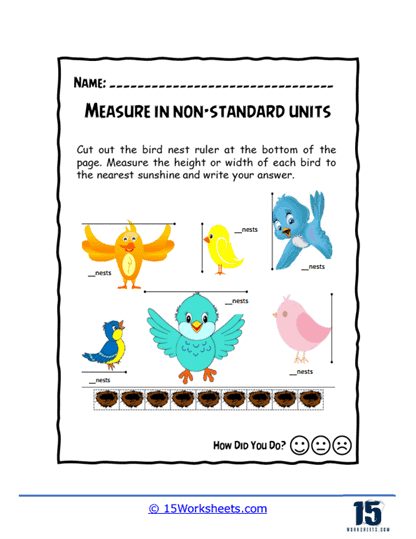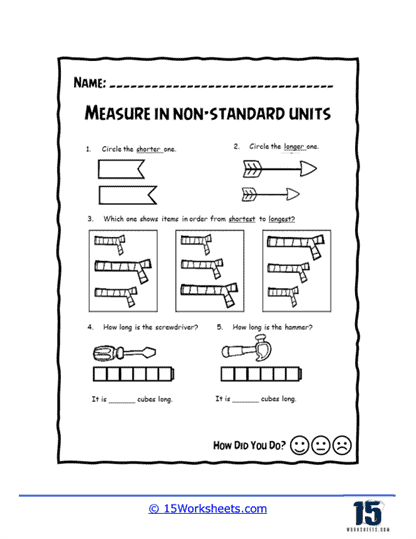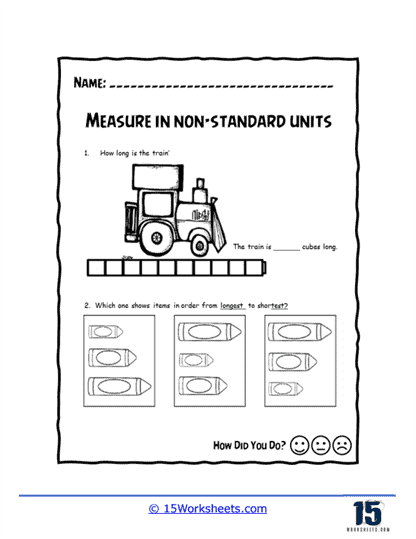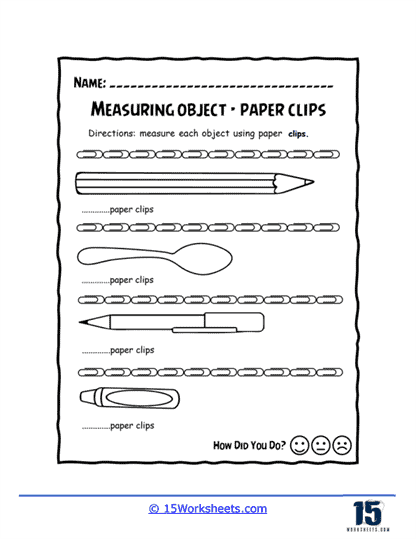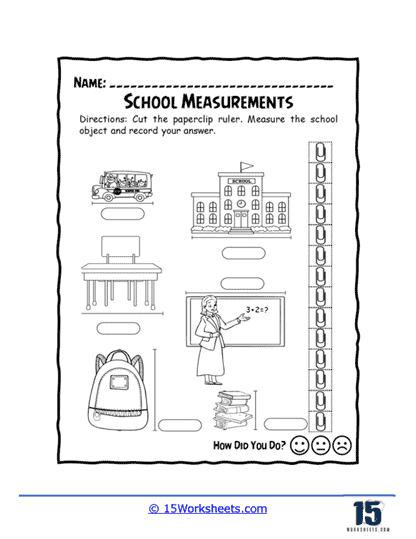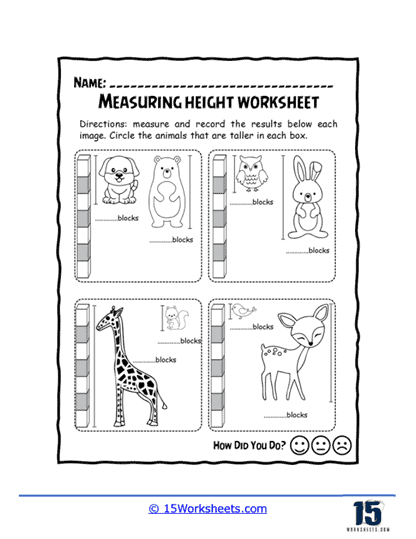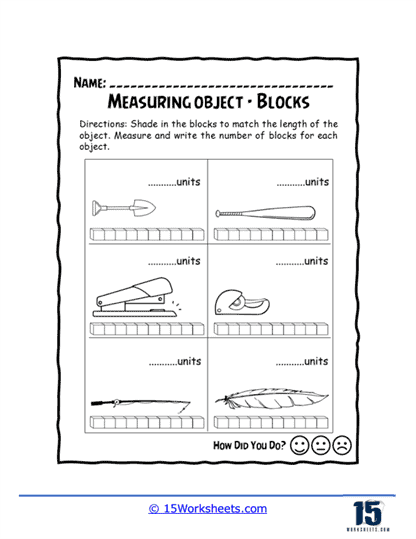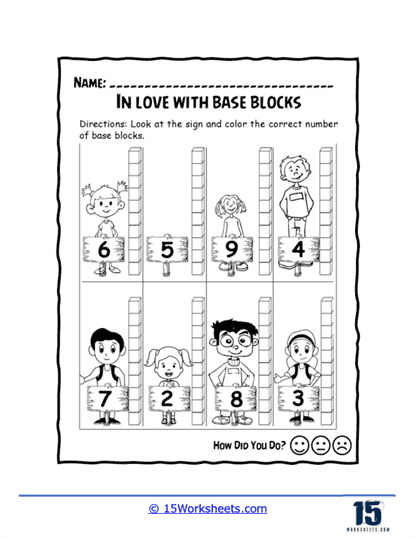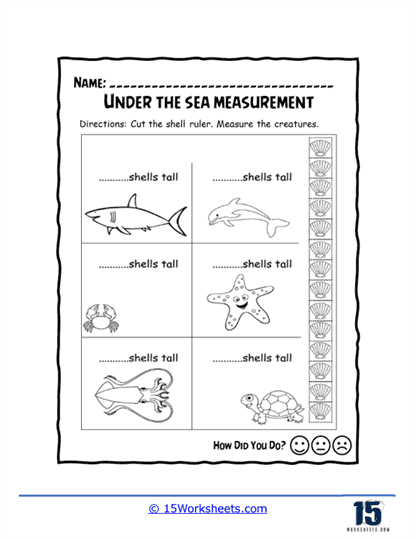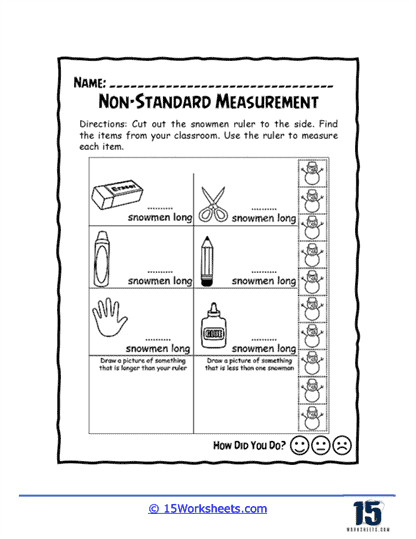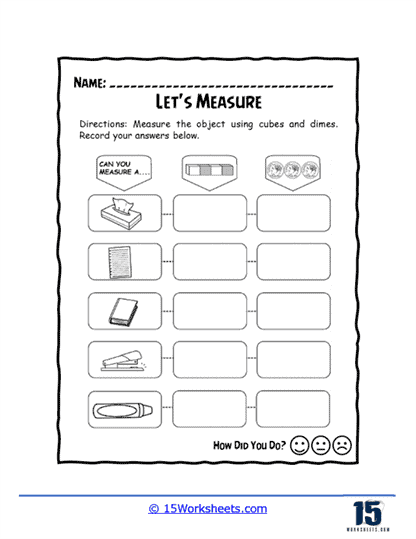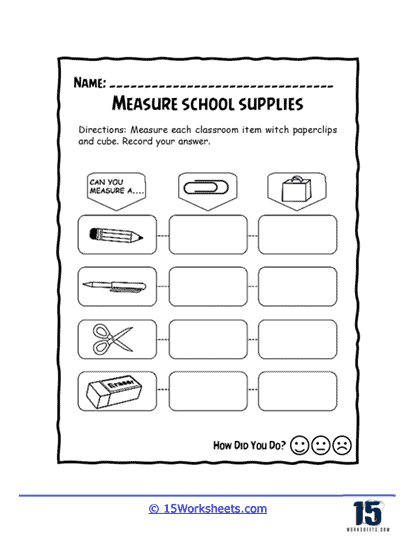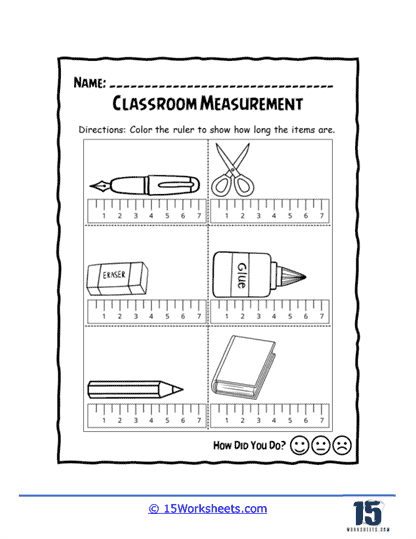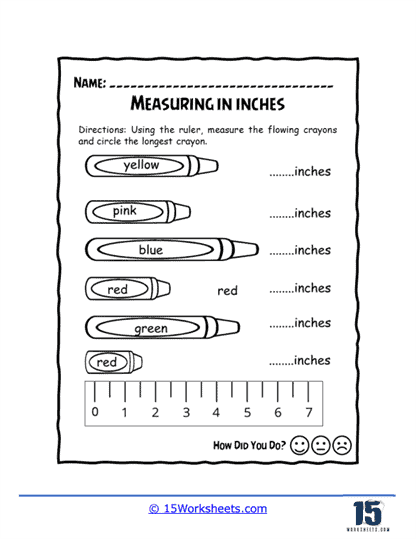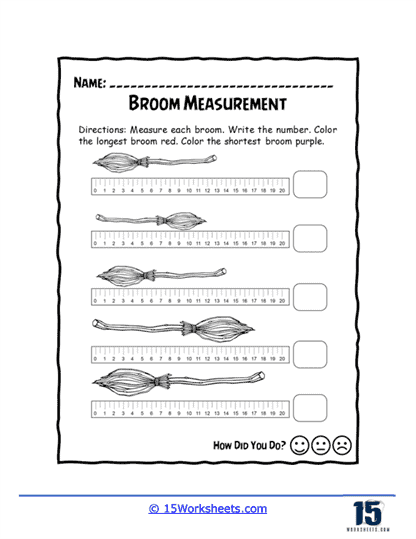Non-Standard Units of Measure Worksheets
About These 15 Worksheets
The collection of non-standard units of measure worksheets provides an invaluable set of educational tools designed to introduce students to fundamental measurement concepts in an engaging, hands-on way. These worksheets depart from the typical reliance on standard units like inches, centimeters, or meters, opting instead for everyday objects such as paperclips, cubes, or shells to act as measuring tools. By leveraging these familiar items, the worksheets simplify the often abstract idea of measurement, transforming it into something that young learners can relate to and visualize. This approach helps bridge the gap between abstract mathematical principles and the tangible, physical world, making measurement a more accessible concept for students just beginning to explore the idea.
The use of non-standard units is a crucial step in the learning process because it aligns measurement with everyday experiences. For example, a child might not have a clear mental image of how long an inch is, but they know how big a paperclip or a block feels in their hand. This tangibility is vital as it makes measurement seem less intimidating and more intuitive. As students manipulate these everyday objects to measure lengths, heights, or even weights, they are not only learning the rudiments of measurement but also reinforcing critical foundational skills such as estimation, comparison, and reasoning. The hands-on nature of these activities engages them in ways that traditional, abstract problems often do not.
One of the essential skills these worksheets foster is spatial awareness. Through exercises that ask students to measure various objects using non-standard items, they begin to develop a more sophisticated understanding of the space around them. This skill is especially critical for younger students who are still learning to navigate and interpret the world in terms of dimensions and proportions. By measuring the lengths or widths of different objects, students gain a clearer sense of how objects relate to one another in terms of size. This spatial understanding is a building block not only for mathematical learning but also for cognitive development in general. Children who can visualize the relationships between objects will find it easier to grasp more advanced concepts in geometry, physics, and even art later on.
Non-standard measurement activities help nurture logical reasoning and problem-solving skills. Many of the worksheets are designed to encourage critical thinking by asking students to compare objects, identify patterns, or make decisions based on their measurements. For instance, an exercise might prompt students to order objects by size or determine which of two objects is longer or shorter. These tasks require children to apply logic, analyze information, and draw conclusions based on the data they observe, which strengthens their ability to reason. By working through problems such as “Which object is the longest?” or “Circle the shorter item,” students are not just learning about measurement-they are practicing how to think critically, a skill that will serve them well throughout their academic journey.
Another significant benefit of non-standard units of measure worksheets is their impact on language development. These worksheets are not only mathematical tools but also platforms for expanding students’ vocabulary and improving their language comprehension. Measurement-related terms like “longer,” “shorter,” “heavier,” or “taller” are used frequently throughout the exercises, and students become increasingly comfortable with these descriptive words as they work through the problems. This helps build their vocabulary and enhances their ability to express ideas clearly and accurately. Moreover, by communicating their observations—whether verbally or in writing-students reinforce their understanding of both the measurement concepts and the language used to describe them.
The integration of measurement with language arts is an often-overlooked aspect of these worksheets. The activities frequently require students to follow written instructions, which can involve multiple steps or complex directions. This requirement helps improve reading comprehension as students must carefully interpret what they are asked to do, ensuring they understand each step before proceeding. In addition to the direct impact on their reading skills, students also benefit from the opportunity to practice writing and speaking about their measurements. For example, they might be asked to explain why one object is longer than another or describe how many paperclips long a pencil is. These exercises challenge students to use full sentences and proper descriptive language, reinforcing their communication skills.
The worksheets also promote an interdisciplinary learning approach by blending math with reading and logical thinking. One common type of exercise asks students to measure objects using non-standard units—such as blocks, erasers, or pencils-and then compare their results. For instance, a typical question might be, “How many paperclips long is the crayon? Is the pencil longer or shorter than the crayon?” This type of problem not only develops measurement skills but also requires students to use comparison words, reinforcing both mathematical understanding and language abilities. Additionally, students must interpret the questions carefully, further honing their reading comprehension as they decipher instructions and apply them to their tasks.
Beyond simple comparisons, some worksheets ask students to sort or categorize objects based on attributes like size, weight, or volume. For example, a worksheet might prompt students to “list three objects in the room that are lighter than your notebook” or “write a sentence explaining why one object is heavier than another.” These activities encourage students to think critically about the objects in their environment and apply their knowledge of measurement while practicing sentence construction and vocabulary use. This combination of logical thinking and language arts enriches the learning experience, making it both educational and engaging.
What Are Non-Standard Units of Measure?
Non-standard units of measure are a vital teaching tool that offers an accessible introduction to the world of measurement for young learners. These units are not part of a formal system like the metric or imperial systems, which are commonly used around the globe. Instead, non-standard units are informal, everyday items that help estimate size, length, weight, or capacity. These units make the abstract concept of measurement feel more concrete, particularly for children, by utilizing objects that are familiar and tangible. This hands-on approach lays the foundation for understanding more complex measurement systems later in life, all while engaging students in a fun and interactive way.
For instance, when young children are first introduced to the idea of length, they may be asked to measure how long a table is using paperclips instead of a ruler. The concept of “how long” becomes far easier to grasp when they can see how many paperclips, which they are familiar with, fit along the edge of the table. Similarly, when thinking about weight, children might compare how heavy their toy block is by holding it in one hand and comparing it to the weight of an apple in the other. These everyday experiences allow children to interact directly with the concept of measurement in ways that feel natural and intuitive. Through these exercises, they begin to learn how to quantify the world around them in a way that feels less abstract and more personal.
The Importance in Early Learning
One of the key reasons non-standard units of measurement are so effective in early learning environments is because they help demystify what can be an otherwise complicated concept. For young children, the idea of a centimeter or a pound may not mean much since these units are foreign and not part of their everyday experience. However, by using items that they are familiar with-like spoons, toys, or even their own hands-children are better able to conceptualize and understand the process of measuring. This helps them make meaningful connections between the concept of size, distance, and weight, and the objects they interact with daily.
For example, when children are tasked with using their own footsteps to measure the length of a hallway, they can immediately relate to the measurement. They understand what their footsteps feel like, and by counting them, they can easily grasp the length of the hallway. The physical act of walking it out ties a kinesthetic learning element to the abstract concept of distance. Similarly, by pouring water into a cup to measure volume, they can visualize how much space the water takes up, making the idea of capacity something they can see, feel, and engage with.
Using non-standard units also encourages children to develop a sense of estimation and approximation, skills that are critical in many real-world scenarios. Estimation helps children make informed guesses about quantities, distances, and sizes, a cognitive process they will rely on long after they have moved on to using standard units of measure. In these early stages, the exactness of the measurement is less important than the child’s ability to think critically about size and comparison. These are fundamental skills not only for math but for overall cognitive development.
Examples of Non-Standard Units of Measure
Non-standard units come in many forms, each suited to measuring different types of quantities. The beauty of these units is their simplicity-they can be found in everyday environments, making learning accessible at home, in the classroom, or even outdoors.
Length – One of the most commonly explored dimensions using non-standard units is length. Teachers often ask children to measure the distance or length of objects using paperclips, pencils, or their own hands. A child may be asked, “How many pencils long is the book?” This type of exercise encourages comparison and allows children to understand that some things are longer or shorter in a way that makes sense to them. Using items like crayons, blocks, or even shoes to measure length helps them build a foundational understanding of distance.
Weight – Weight is another measurement concept that can be difficult for young learners to grasp through standard units like pounds or kilograms. Instead, children can compare the weight of objects using things they can physically hold and understand, such as toy blocks or apples. If a teacher asks, “Which is heavier, the book or the apple?” the child can feel the difference and make a judgment based on physical sensation. This tactile approach makes it easier for children to understand weight in a real, experiential way.
Capacity – Estimating the capacity or volume of a container is another area where non-standard units can be used to great effect. Instead of trying to visualize a liter or gallon, children might use cups, spoons, or even handfuls of objects like marbles to estimate how much a container can hold. A teacher might ask, “How many cups of sand can fit in this bucket?” These types of activities help children understand the concept of volume by engaging them with objects they encounter daily.
Time – Although time is usually measured in minutes and seconds, non-standard units of time can be helpful for teaching young children about the passage of time. For instance, instead of telling a child to wait for five minutes, a teacher might say, “We’ll clean up after we listen to two more songs.” Using familiar markers like songs or the duration of a TV show helps children begin to comprehend time in a way that feels more natural. Over time, this understanding can transition into using clocks and calendars.

